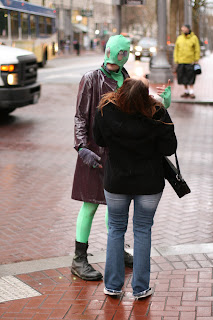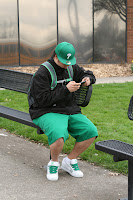I take a lot of photos, as a street photographer is prone to do. If I shot the 2014 budget here at school, it might be like seeing an imploding mountain of bricks.
The baseball program was just one of many that did not survive budget scrutiny. In 2013, Linn Benton Community College administration was forced to cut 2.9 million dollars from its budget, in the wake of less funding and revenue.
Turning Point Transitions(TPT), a community program, was cut. TPT was instrumental in the community, and was engineered to help the needy get on the road to an education, with employment in the community the end goal. TPT was a twice-per-term, four week, free class designed to meet the needs of low-income community and their families, by teaching life skills essential to decision making and employment.
LBCC Graphic Arts did not escape the budget wrath, nor did Women's Basketball or English Speakers of Other Languages(ESOL). The Center for Teaching and Learning was also eliminated, and LBCC President Greg Hamann stated, "Again, this program provides some very valuable services, but current fiscal circumstances dictate we do without...At some point we will need to revisit this."
In all, April proved devastating to more than two dozen LBCC employees(unemployed), and countless students.
Less than a month later, a Seattle photographer was "bought" by LBCC via "strategic investment and LBCC Foundation funds," said Dale Stowell, LBCC. For two days this pro from 300 miles away, made a few grand for his vacation in the Willamette Valley, while local students, teachers, and community faced severe budget cuts. Cuts that changed lives.
I know it is within the rules, it is money in a particular budget. Yes, the rules need to change. That money should be "rolled over" and distributed as part of the next budget. The rules say no, that the money is gone at the end of the fiscal term.
I also know that the money spent is for professional, high quality photos, that LBCC can use for 3 to 4 years, according to Stowell. This sort of expense is vital to the "attractability" of the college and its success in recruiting students. "We received 1000 edited photos," said Stowell.
But even so, we should ask ourselves:
Should we spend money on professional photographers from Anywhere, USA? Especially in the wake of such status quo altering budget cuts? How do we justify giving this photog a vacation? And make no mistake, this particular shoot was a walk in the park.
The fact that LBCC's Journalism Department(JN) is ignored for these types of assignments is fundamentally an error in managing money and resources. The JN is not only full of photojournalists, but the department oversees the campus newspaper, The Commuter, which has a bevy of photographers with professional equipment. I know of two right now that own full-frame digital, single lens reflex cameras(DSLR), with pro lenses. Neither of those Commuter photogs is myself, as I own crop sensor(smaller) DSLRs and 35mm film cameras, in addition to a 1937 Zeiss Ikon that belonged to my grandfather. It takes great photos of the Paulson Greenhouse, as does the 1973 Canon EF.
The LBCC Paulson Greenhouse, shot with a 1973 35mm SLR, Canon EF & Albinar 28mm f2.8 Macro
In theory, the paper(and other relevant departments) should adequately and inexpensively cover these sorts of "in-house" tasks, and in return provide both the school and student with robust education. Then, the robust LBCC education would exponentially enhance the economic vitality of our community, by keeping costs down and enlightening the community. A well educated, budget conscious, hard working labor force is what the example should be.
Instead, we burned dinosaur bones and pumped some dough into Seattle's economy.
I shiver when I think of trying to explain this pro photog expense to the faculty in Graphic Arts, who also were substantially affected by the budget woes. The arts program is on temporary hold while money and curriculum is redesigned. Yet, this is another LBCC program that can be instrumental regarding campus tasks, especially in marketing brochures. And is not used to its full potential in that regard.
When one considers the number of faculty and staff at LBCC, who were devastated by the loss of a job, the idea of spending "a four or five grand" on a photographer seems not only outrageous, it seems ugly.
In a candid email, LBCC's Dale Stowell said, "The photography is part of a 2012 funded project to upgrade LBCC's website and photo library." Stowel also added that LBCC "owns" the photos and catalogs them. The photos are professionally shot and edited by a successful marketing photographer. Stowell added that the cost per photo is a great price, and is a discounted rate for the college.
The innovative and ambitious approach to excellence in education is not lost in Stowell. From efforts to establish an Alternative Fuels Center in Lebanon, to projects like marketing photography, Stowell has local education first in mind.
But the cost is now, nevertheless.
The LBCC Marketing team, and Stowell's office, cannot be blamed, as they do awesome work and have a wonderful attitude. But once again, should we as a group, not spend this money?
It is a discussion we need to have.
An LBCC baseball game.
Now moving forward to credibility issues regarding media. Much has been said lately of the LBCC newspaper as being identity-less, biased, and generally uncredible. In various interviews with students, a small number did not read the paper for the stated reason "skepticism." An even smaller number than that had an exact example of the reason for skepticism.
At the LBCC Diversity Day, The Commuter booth buzzed with traffic. Many were asked "Do you read The Commuter?" Many answered "No."
The main reason students do not read the campus paper(or any paper) is simple demographics. The average age of the LBCC student is 27, which is well past the newspaper heyday. They simply do not read printed news. News on Facebook, Pinterest, Twitter, and a host of other websites, along with traditional news like NBC Nightly News and The New York Times, are all on the internet. And on our phones.
In two dozen interviews at various times and concerning different topics, the question was posed to faculty, about whether or not to be quoted. In all of these instances, the topic was a bit hot. A substantial number asked not to be quoted by the paper. Which is normal for a touchy subject, but often the tone seemed to say, If I was a different paper...things might be different.
Even when the topic was not so hot, some were reluctant to be quoted.
Sometimes contracts and unions prevent comments, and sometimes people do not comment because of retribution and conflict that may be caused by commenting.
Because of certain columns and editorials in The Commuter, a few scathing letters from faculty have seen the editor's desk, and the advisor's I am sure. One Commuter article referred to faculty as "apathetic" and another claimed immigration was a sort of entitlement.
In the April 17, 2013 issue of The Commuter, a letter to the editor asked the editorial staff, "Just what does your publication stand for?" The tone of the text should resonate deep in the treads of The Commuter. The query went on to ask "...if The Commuter is a purveyor of propaganda?"
A letter dated Feb. 15, tells the paper, "I take umbrage at the assertion that the LBCC faculty are apathetic towards broad student achievement." Umbrage means offense, and the instructor was offended by a label the paper applied to the entire LBCC staff.
Another asked "Why The Commuter would run a street photography rules article?"
Judging budding writers and holding them accountable is good, dismissing their credentials based on growing pains is not good.
It is these assessments, in my opinion, that lead to an attitude of, "The Commuter cannot handle this task," which is unfortunate. In the above paragraphs, questions about spending policy at LBCC are front and center. Those policies should include LBCC entities such as The Commuter, the ITS Welding Club, Graphic Arts, Student Life & Leadership, and countless others.
As for The Commuter being unable to handle "brochure photography" and any photography, for that matter, the paper is well equipped to shoot whatever photos LBCC needs. Photoshop is available for editing as well.
These points would be deservedly discussed, if I had my way.
In an informative and creative article, JN student Emily Smucker wrote a piece about the literal cost of skipping a class, from the eyes of a budget minded, frugal, and thrifty student. This shows that students(some) are aware of the costs of education.
The newspaper has seen, in the last year or so, local news that informs, tech reports that are informative, profiles of LBCC personalities, photo galleries, reviews, dating columns, LBCC's various event coverage, art coverage, sports and opinions, and largely has been a weekly relevant read. The newspaper has shown an attitude of free speech and information, while simultaneously being entertaining.
The Commuter has made mistakes more severe than just a few typos. And those mistakes have drawn scrutiny. Errors in reporting facts and mistakes in presentation can and will happen at any news outlet. Commuter Editor-in-Chief Sean Bassinger says avoiding errors is his Number 1 priority. "More than anything, I want writers to learn from their mistakes," said Bassinger.
But what we are all forgetting here, in our scorn of the paper, is that the JN curriculum, and specifically The Commuter, are places that the craft is learned. The department is building the journalist of tomorrow. The very writers that are deemed unworthy of hiring or even reading, are the LBCC writers who next year will be at Portland State University, the University of Oregon, and Oregon State University.
Mistakes will be made, and mistakes will be corrected and learned from.
The fact is, the nature of the JN curriculum is a revolving door of staff writers mixed with student "voices" that are encouraged to have boldness and passion. Let them speak, and if they are wrong, let's right the ship.
Dale Hummel, Staff Photographer & Distribution Specialist at The Commuter
Integrity. A noun, meaning "moral, ethical, soundness of moral character, honesty" - from the awesome website dictionary.com and accessible anytime, anywhere.
Use it, even if you are not a journalist.










































.JPG)

.JPG)














































































